Market Structures: Monopolies, Duopolies, and Oligopolies in Australia
VerifiedAdded on 2019/11/26
|6
|1567
|28
Essay
AI Summary
This essay provides an economic analysis of market structures in Australia, specifically focusing on monopolies, duopolies, and oligopolies. It begins by introducing the concept of market concentration and its potential impact on profitability and innovation. The essay then defines and differentiates various market structures, including perfect competition, monopoly, oligopoly, monopolistic competition, and monopsony, highlighting their unique characteristics. The core of the essay examines how monopolies, duopolies, and oligopolies thrive in the Australian market due to factors such as lower government regulation and pricing strategies. The author presents their viewpoint on the viability of these market structures, suggesting strategies for firms operating within them, such as employing specific pricing strategies or creating barriers to entry. The essay concludes by reiterating the suitability of these structures for the Australian economy and their potential for profitability, while contrasting them with the challenges faced by firms in perfectly competitive markets. The essay also offers recommendations for both key players and policy makers to manage the competitive landscape within the Australian market.
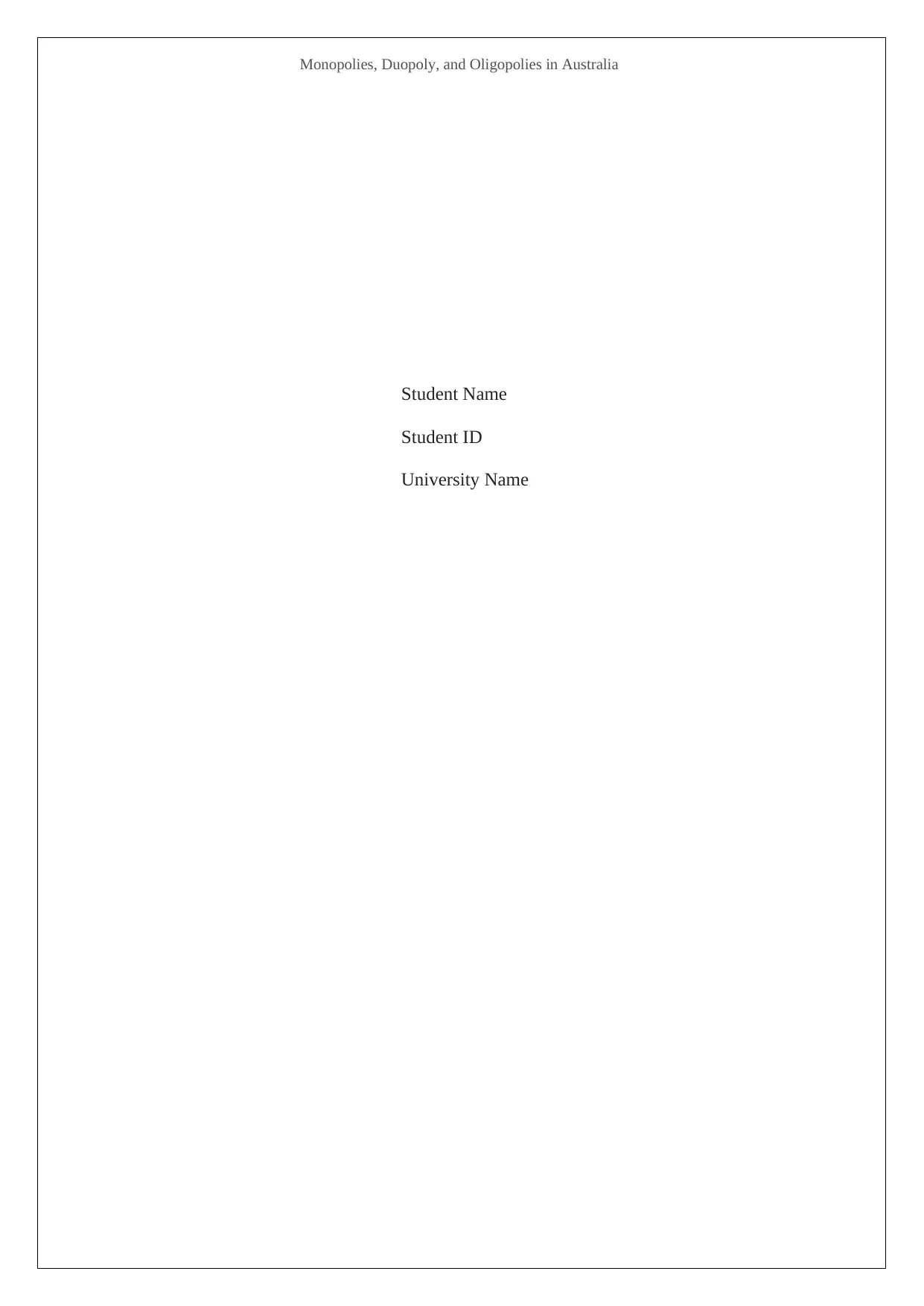
Monopolies, Duopoly, and Oligopolies in Australia
Student Name
Student ID
University Name
Student Name
Student ID
University Name
Paraphrase This Document
Need a fresh take? Get an instant paraphrase of this document with our AI Paraphraser
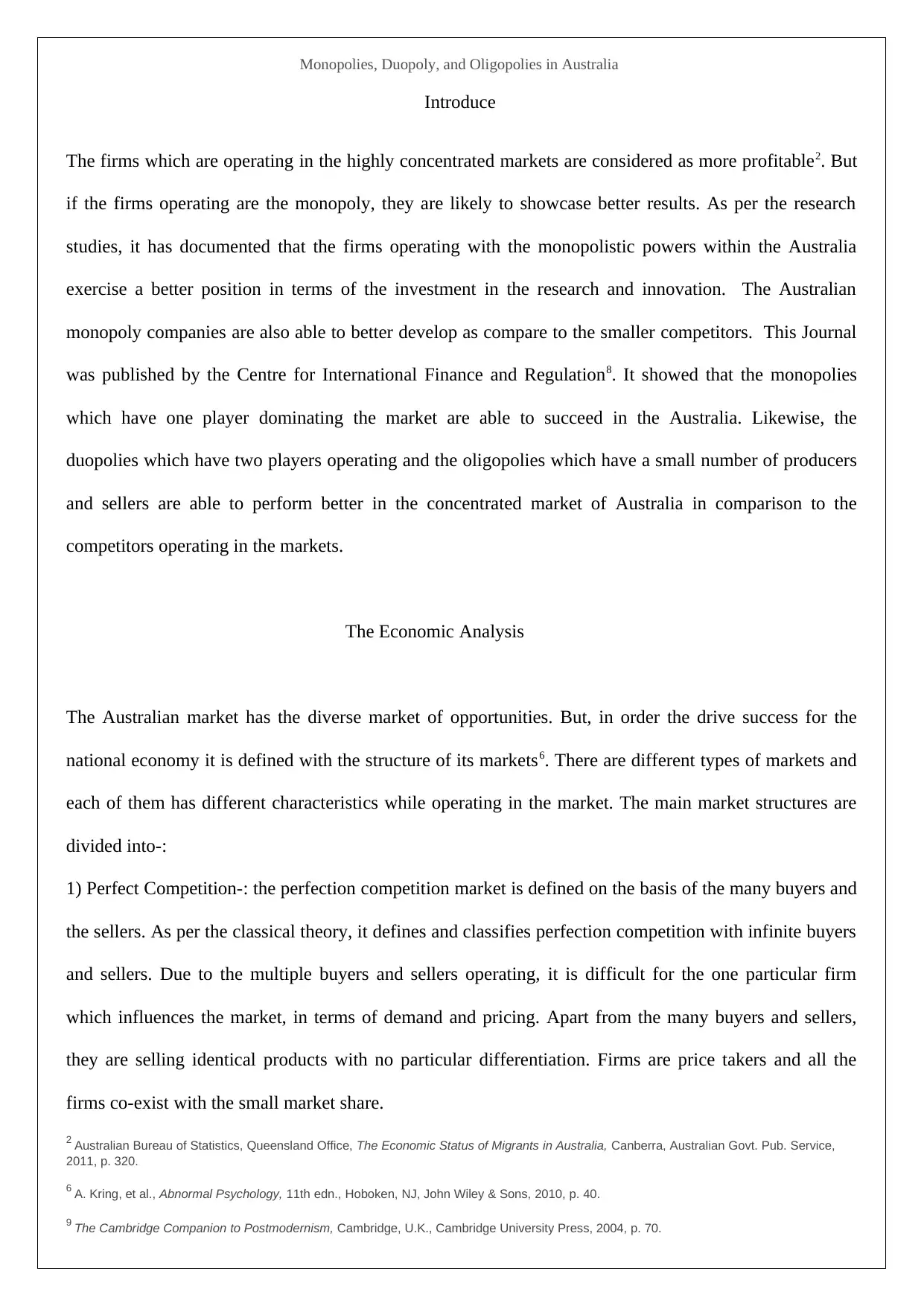
Monopolies, Duopoly, and Oligopolies in Australia
Introduce
The firms which are operating in the highly concentrated markets are considered as more profitable2. But
if the firms operating are the monopoly, they are likely to showcase better results. As per the research
studies, it has documented that the firms operating with the monopolistic powers within the Australia
exercise a better position in terms of the investment in the research and innovation. The Australian
monopoly companies are also able to better develop as compare to the smaller competitors. This Journal
was published by the Centre for International Finance and Regulation8. It showed that the monopolies
which have one player dominating the market are able to succeed in the Australia. Likewise, the
duopolies which have two players operating and the oligopolies which have a small number of producers
and sellers are able to perform better in the concentrated market of Australia in comparison to the
competitors operating in the markets.
The Economic Analysis
The Australian market has the diverse market of opportunities. But, in order the drive success for the
national economy it is defined with the structure of its markets6. There are different types of markets and
each of them has different characteristics while operating in the market. The main market structures are
divided into-:
1) Perfect Competition-: the perfection competition market is defined on the basis of the many buyers and
the sellers. As per the classical theory, it defines and classifies perfection competition with infinite buyers
and sellers. Due to the multiple buyers and sellers operating, it is difficult for the one particular firm
which influences the market, in terms of demand and pricing. Apart from the many buyers and sellers,
they are selling identical products with no particular differentiation. Firms are price takers and all the
firms co-exist with the small market share.
2 Australian Bureau of Statistics, Queensland Office, The Economic Status of Migrants in Australia, Canberra, Australian Govt. Pub. Service,
2011, p. 320.
6 A. Kring, et al., Abnormal Psychology, 11th edn., Hoboken, NJ, John Wiley & Sons, 2010, p. 40.
9 The Cambridge Companion to Postmodernism, Cambridge, U.K., Cambridge University Press, 2004, p. 70.
Introduce
The firms which are operating in the highly concentrated markets are considered as more profitable2. But
if the firms operating are the monopoly, they are likely to showcase better results. As per the research
studies, it has documented that the firms operating with the monopolistic powers within the Australia
exercise a better position in terms of the investment in the research and innovation. The Australian
monopoly companies are also able to better develop as compare to the smaller competitors. This Journal
was published by the Centre for International Finance and Regulation8. It showed that the monopolies
which have one player dominating the market are able to succeed in the Australia. Likewise, the
duopolies which have two players operating and the oligopolies which have a small number of producers
and sellers are able to perform better in the concentrated market of Australia in comparison to the
competitors operating in the markets.
The Economic Analysis
The Australian market has the diverse market of opportunities. But, in order the drive success for the
national economy it is defined with the structure of its markets6. There are different types of markets and
each of them has different characteristics while operating in the market. The main market structures are
divided into-:
1) Perfect Competition-: the perfection competition market is defined on the basis of the many buyers and
the sellers. As per the classical theory, it defines and classifies perfection competition with infinite buyers
and sellers. Due to the multiple buyers and sellers operating, it is difficult for the one particular firm
which influences the market, in terms of demand and pricing. Apart from the many buyers and sellers,
they are selling identical products with no particular differentiation. Firms are price takers and all the
firms co-exist with the small market share.
2 Australian Bureau of Statistics, Queensland Office, The Economic Status of Migrants in Australia, Canberra, Australian Govt. Pub. Service,
2011, p. 320.
6 A. Kring, et al., Abnormal Psychology, 11th edn., Hoboken, NJ, John Wiley & Sons, 2010, p. 40.
9 The Cambridge Companion to Postmodernism, Cambridge, U.K., Cambridge University Press, 2004, p. 70.
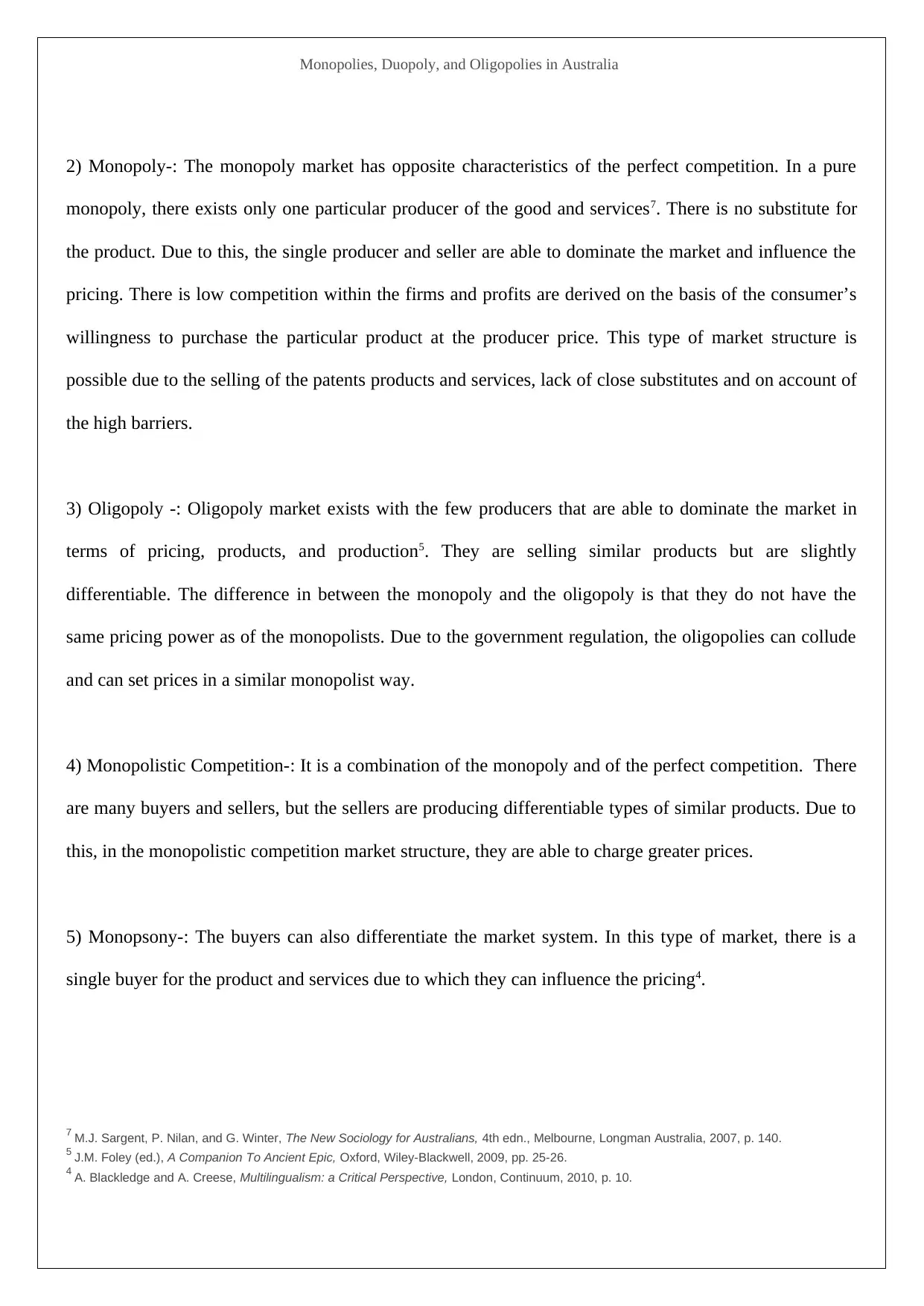
Monopolies, Duopoly, and Oligopolies in Australia
2) Monopoly-: The monopoly market has opposite characteristics of the perfect competition. In a pure
monopoly, there exists only one particular producer of the good and services7. There is no substitute for
the product. Due to this, the single producer and seller are able to dominate the market and influence the
pricing. There is low competition within the firms and profits are derived on the basis of the consumer’s
willingness to purchase the particular product at the producer price. This type of market structure is
possible due to the selling of the patents products and services, lack of close substitutes and on account of
the high barriers.
3) Oligopoly -: Oligopoly market exists with the few producers that are able to dominate the market in
terms of pricing, products, and production5. They are selling similar products but are slightly
differentiable. The difference in between the monopoly and the oligopoly is that they do not have the
same pricing power as of the monopolists. Due to the government regulation, the oligopolies can collude
and can set prices in a similar monopolist way.
4) Monopolistic Competition-: It is a combination of the monopoly and of the perfect competition. There
are many buyers and sellers, but the sellers are producing differentiable types of similar products. Due to
this, in the monopolistic competition market structure, they are able to charge greater prices.
5) Monopsony-: The buyers can also differentiate the market system. In this type of market, there is a
single buyer for the product and services due to which they can influence the pricing4.
7 M.J. Sargent, P. Nilan, and G. Winter, The New Sociology for Australians, 4th edn., Melbourne, Longman Australia, 2007, p. 140.
5 J.M. Foley (ed.), A Companion To Ancient Epic, Oxford, Wiley-Blackwell, 2009, pp. 25-26.
4 A. Blackledge and A. Creese, Multilingualism: a Critical Perspective, London, Continuum, 2010, p. 10.
2) Monopoly-: The monopoly market has opposite characteristics of the perfect competition. In a pure
monopoly, there exists only one particular producer of the good and services7. There is no substitute for
the product. Due to this, the single producer and seller are able to dominate the market and influence the
pricing. There is low competition within the firms and profits are derived on the basis of the consumer’s
willingness to purchase the particular product at the producer price. This type of market structure is
possible due to the selling of the patents products and services, lack of close substitutes and on account of
the high barriers.
3) Oligopoly -: Oligopoly market exists with the few producers that are able to dominate the market in
terms of pricing, products, and production5. They are selling similar products but are slightly
differentiable. The difference in between the monopoly and the oligopoly is that they do not have the
same pricing power as of the monopolists. Due to the government regulation, the oligopolies can collude
and can set prices in a similar monopolist way.
4) Monopolistic Competition-: It is a combination of the monopoly and of the perfect competition. There
are many buyers and sellers, but the sellers are producing differentiable types of similar products. Due to
this, in the monopolistic competition market structure, they are able to charge greater prices.
5) Monopsony-: The buyers can also differentiate the market system. In this type of market, there is a
single buyer for the product and services due to which they can influence the pricing4.
7 M.J. Sargent, P. Nilan, and G. Winter, The New Sociology for Australians, 4th edn., Melbourne, Longman Australia, 2007, p. 140.
5 J.M. Foley (ed.), A Companion To Ancient Epic, Oxford, Wiley-Blackwell, 2009, pp. 25-26.
4 A. Blackledge and A. Creese, Multilingualism: a Critical Perspective, London, Continuum, 2010, p. 10.
⊘ This is a preview!⊘
Do you want full access?
Subscribe today to unlock all pages.

Trusted by 1+ million students worldwide
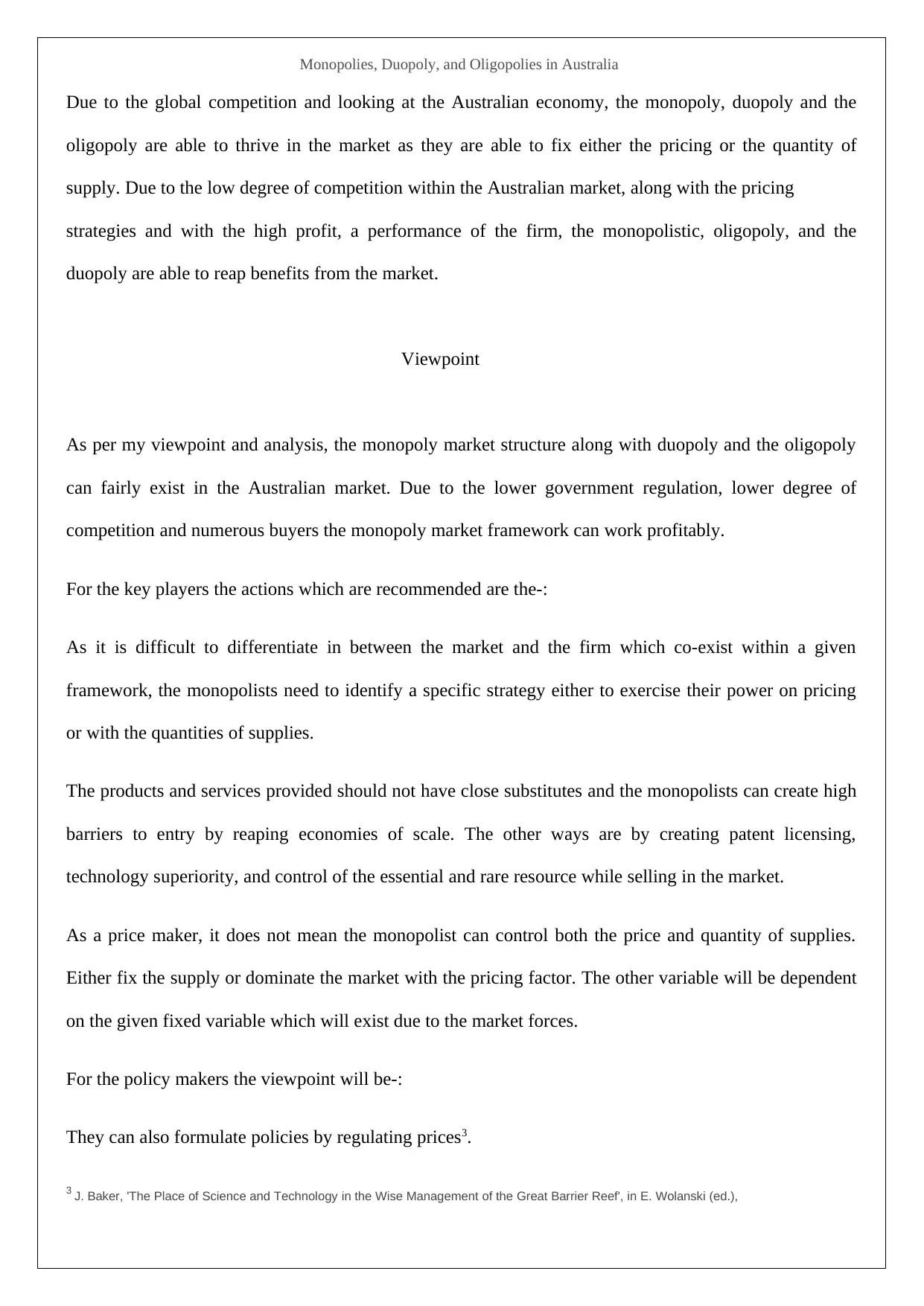
Monopolies, Duopoly, and Oligopolies in Australia
Due to the global competition and looking at the Australian economy, the monopoly, duopoly and the
oligopoly are able to thrive in the market as they are able to fix either the pricing or the quantity of
supply. Due to the low degree of competition within the Australian market, along with the pricing
strategies and with the high profit, a performance of the firm, the monopolistic, oligopoly, and the
duopoly are able to reap benefits from the market.
Viewpoint
As per my viewpoint and analysis, the monopoly market structure along with duopoly and the oligopoly
can fairly exist in the Australian market. Due to the lower government regulation, lower degree of
competition and numerous buyers the monopoly market framework can work profitably.
For the key players the actions which are recommended are the-:
As it is difficult to differentiate in between the market and the firm which co-exist within a given
framework, the monopolists need to identify a specific strategy either to exercise their power on pricing
or with the quantities of supplies.
The products and services provided should not have close substitutes and the monopolists can create high
barriers to entry by reaping economies of scale. The other ways are by creating patent licensing,
technology superiority, and control of the essential and rare resource while selling in the market.
As a price maker, it does not mean the monopolist can control both the price and quantity of supplies.
Either fix the supply or dominate the market with the pricing factor. The other variable will be dependent
on the given fixed variable which will exist due to the market forces.
For the policy makers the viewpoint will be-:
They can also formulate policies by regulating prices3.
3 J. Baker, 'The Place of Science and Technology in the Wise Management of the Great Barrier Reef', in E. Wolanski (ed.),
Due to the global competition and looking at the Australian economy, the monopoly, duopoly and the
oligopoly are able to thrive in the market as they are able to fix either the pricing or the quantity of
supply. Due to the low degree of competition within the Australian market, along with the pricing
strategies and with the high profit, a performance of the firm, the monopolistic, oligopoly, and the
duopoly are able to reap benefits from the market.
Viewpoint
As per my viewpoint and analysis, the monopoly market structure along with duopoly and the oligopoly
can fairly exist in the Australian market. Due to the lower government regulation, lower degree of
competition and numerous buyers the monopoly market framework can work profitably.
For the key players the actions which are recommended are the-:
As it is difficult to differentiate in between the market and the firm which co-exist within a given
framework, the monopolists need to identify a specific strategy either to exercise their power on pricing
or with the quantities of supplies.
The products and services provided should not have close substitutes and the monopolists can create high
barriers to entry by reaping economies of scale. The other ways are by creating patent licensing,
technology superiority, and control of the essential and rare resource while selling in the market.
As a price maker, it does not mean the monopolist can control both the price and quantity of supplies.
Either fix the supply or dominate the market with the pricing factor. The other variable will be dependent
on the given fixed variable which will exist due to the market forces.
For the policy makers the viewpoint will be-:
They can also formulate policies by regulating prices3.
3 J. Baker, 'The Place of Science and Technology in the Wise Management of the Great Barrier Reef', in E. Wolanski (ed.),
Paraphrase This Document
Need a fresh take? Get an instant paraphrase of this document with our AI Paraphraser
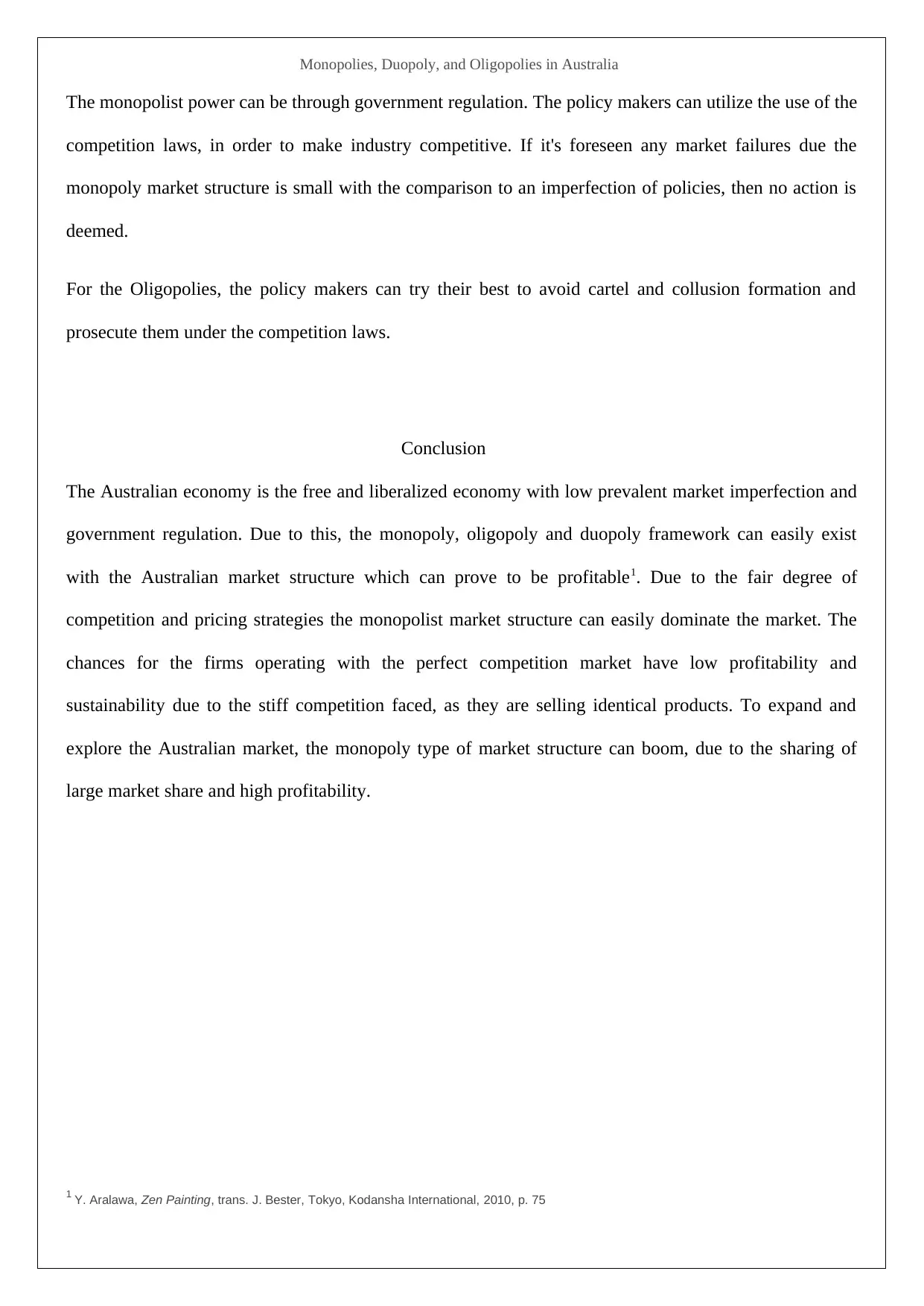
Monopolies, Duopoly, and Oligopolies in Australia
The monopolist power can be through government regulation. The policy makers can utilize the use of the
competition laws, in order to make industry competitive. If it's foreseen any market failures due the
monopoly market structure is small with the comparison to an imperfection of policies, then no action is
deemed.
For the Oligopolies, the policy makers can try their best to avoid cartel and collusion formation and
prosecute them under the competition laws.
Conclusion
The Australian economy is the free and liberalized economy with low prevalent market imperfection and
government regulation. Due to this, the monopoly, oligopoly and duopoly framework can easily exist
with the Australian market structure which can prove to be profitable1. Due to the fair degree of
competition and pricing strategies the monopolist market structure can easily dominate the market. The
chances for the firms operating with the perfect competition market have low profitability and
sustainability due to the stiff competition faced, as they are selling identical products. To expand and
explore the Australian market, the monopoly type of market structure can boom, due to the sharing of
large market share and high profitability.
1 Y. Aralawa, Zen Painting, trans. J. Bester, Tokyo, Kodansha International, 2010, p. 75
The monopolist power can be through government regulation. The policy makers can utilize the use of the
competition laws, in order to make industry competitive. If it's foreseen any market failures due the
monopoly market structure is small with the comparison to an imperfection of policies, then no action is
deemed.
For the Oligopolies, the policy makers can try their best to avoid cartel and collusion formation and
prosecute them under the competition laws.
Conclusion
The Australian economy is the free and liberalized economy with low prevalent market imperfection and
government regulation. Due to this, the monopoly, oligopoly and duopoly framework can easily exist
with the Australian market structure which can prove to be profitable1. Due to the fair degree of
competition and pricing strategies the monopolist market structure can easily dominate the market. The
chances for the firms operating with the perfect competition market have low profitability and
sustainability due to the stiff competition faced, as they are selling identical products. To expand and
explore the Australian market, the monopoly type of market structure can boom, due to the sharing of
large market share and high profitability.
1 Y. Aralawa, Zen Painting, trans. J. Bester, Tokyo, Kodansha International, 2010, p. 75
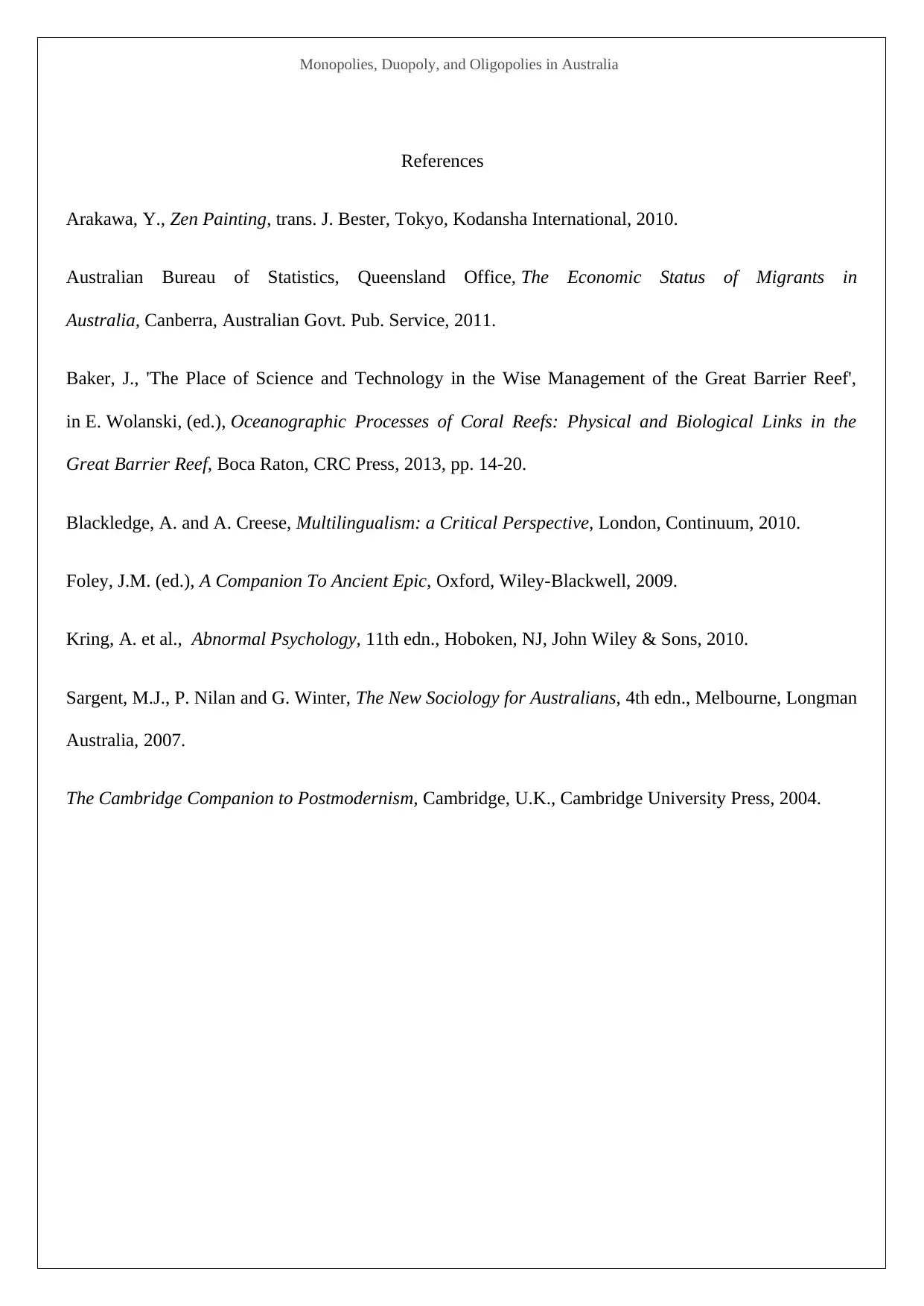
Monopolies, Duopoly, and Oligopolies in Australia
References
Arakawa, Y., Zen Painting, trans. J. Bester, Tokyo, Kodansha International, 2010.
Australian Bureau of Statistics, Queensland Office, The Economic Status of Migrants in
Australia, Canberra, Australian Govt. Pub. Service, 2011.
Baker, J., 'The Place of Science and Technology in the Wise Management of the Great Barrier Reef',
in E. Wolanski, (ed.), Oceanographic Processes of Coral Reefs: Physical and Biological Links in the
Great Barrier Reef, Boca Raton, CRC Press, 2013, pp. 14-20.
Blackledge, A. and A. Creese, Multilingualism: a Critical Perspective, London, Continuum, 2010.
Foley, J.M. (ed.), A Companion To Ancient Epic, Oxford, Wiley-Blackwell, 2009.
Kring, A. et al., Abnormal Psychology, 11th edn., Hoboken, NJ, John Wiley & Sons, 2010.
Sargent, M.J., P. Nilan and G. Winter, The New Sociology for Australians, 4th edn., Melbourne, Longman
Australia, 2007.
The Cambridge Companion to Postmodernism, Cambridge, U.K., Cambridge University Press, 2004.
References
Arakawa, Y., Zen Painting, trans. J. Bester, Tokyo, Kodansha International, 2010.
Australian Bureau of Statistics, Queensland Office, The Economic Status of Migrants in
Australia, Canberra, Australian Govt. Pub. Service, 2011.
Baker, J., 'The Place of Science and Technology in the Wise Management of the Great Barrier Reef',
in E. Wolanski, (ed.), Oceanographic Processes of Coral Reefs: Physical and Biological Links in the
Great Barrier Reef, Boca Raton, CRC Press, 2013, pp. 14-20.
Blackledge, A. and A. Creese, Multilingualism: a Critical Perspective, London, Continuum, 2010.
Foley, J.M. (ed.), A Companion To Ancient Epic, Oxford, Wiley-Blackwell, 2009.
Kring, A. et al., Abnormal Psychology, 11th edn., Hoboken, NJ, John Wiley & Sons, 2010.
Sargent, M.J., P. Nilan and G. Winter, The New Sociology for Australians, 4th edn., Melbourne, Longman
Australia, 2007.
The Cambridge Companion to Postmodernism, Cambridge, U.K., Cambridge University Press, 2004.
⊘ This is a preview!⊘
Do you want full access?
Subscribe today to unlock all pages.

Trusted by 1+ million students worldwide
1 out of 6
Related Documents
Your All-in-One AI-Powered Toolkit for Academic Success.
+13062052269
info@desklib.com
Available 24*7 on WhatsApp / Email
![[object Object]](/_next/static/media/star-bottom.7253800d.svg)
Unlock your academic potential
Copyright © 2020–2025 A2Z Services. All Rights Reserved. Developed and managed by ZUCOL.





